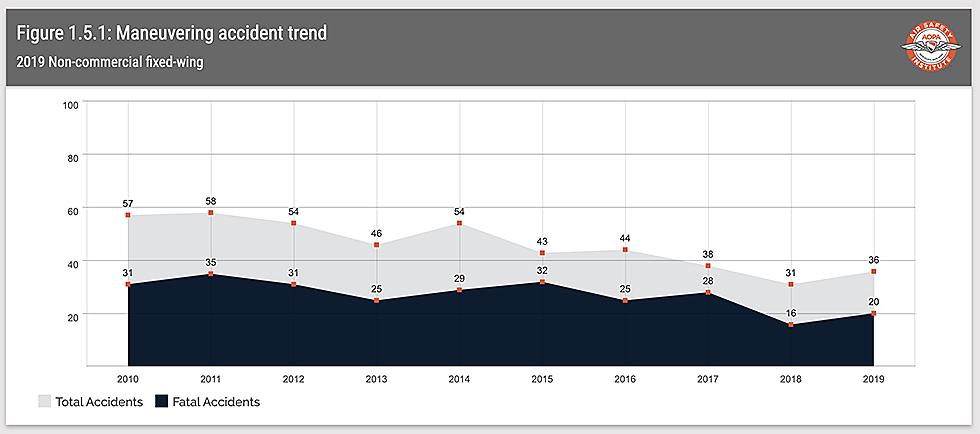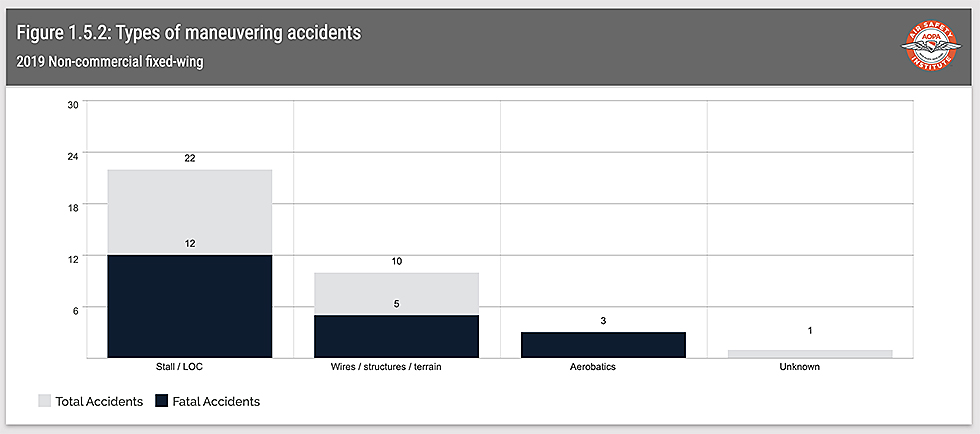Loss of Control and a Quick Stall Recovery Technique: Don’t Let the Test Come Before the Training

The Loss of Control [LOC] accident category remains the National Transportation Safety Board’s [NTSB] number one cause of fatal accidents. Loss of control can occur both on the ground as well as inflight, with inflight events, of course, being the most likely to cause a fatality.
This subject area is quite broad and has received a lot of study from the FAA and other agencies over the past few years. An FAA Safety Analysis Team study looked at 1,249 fatal accidents from 2001 to 2010 and found that 40.2% of fatalities occurred during a LOC event.
The one-year Nall Reports below reinforces the frequency of LOC events, although fatalities are fewer.


Here’s an official definition:
“A LOC accident involves an aircraft’s unintended departure from controlled flight.”
The most common type of LOC is a stall, including a post-stall spin, which can occur when the pilot allows the aircraft to enter a flight regime outside its normal flight envelope.
I like this definition:
“When the airplane goes where the pilot doesn’t expect or when it won’t go where the pilot intends.”
LOC accidents occur after a pilot does not maintain or regain aircraft control. More than 25% of general aviation fatal accidents occur during the maneuvering phase of flight, which means turning, climbing, or descending, usually close to the ground where altitude to recover is small.
These unexpected stalls can result from multiple pilot distractions, such as searching for traffic, responding to unexpected ATC instructions, or focusing on aircraft malfunctions (an open door on takeoff). In addition, stalls can result from being improperly trimmed for the power and maneuver performed, such as during a go-around with lots of nose up trim which was necessary during the approach phase. These and multiple other distractions can lead to loss of situational awareness and failure to observe decreasing airspeed.
Additional contributing factors may include:
- Poor judgment/aeronautical decision making
- Weather
- Loss of situational awareness
- Failure to recognize an aerodynamic stall or spin and execute corrective action
- Intentional regulatory non-compliance
- Unfamiliarity with the aircraft
- Failure to maintain airspeed
- Failure to follow procedure
- Pilot inexperience and proficiency
The largest contributing factor (85%) to LOC occurs when a pilot overreacts or mis-applies controls after finally recognizing that a stall or upset has occurred. This finding is rather interesting. Throw in some “startle response” and you have a near-certain LOC.
So why should we study this subject? The answer is because you can prevent it!
Don’t think immunity is conferred because you are highly experienced or have thousands of hours in your logbook. Some noteworthy examples include the Air France airliner that experiences some instrument anomalies while cruising at 35,000 feet. The crew managed to put the plane into a stall from a stable condition which they were unable to recover before falling 6 miles into the Atlantic Ocean.
Air Asia flight 8501 was aggressively maneuvering to avoid weather at 38,000 feet, stalled and never recovered. Two recent Lear Jet accidents with experienced professional crews on board were performing circling approaches, both in VMC with one at night, stalled in the turns too low to recover normal flight attitude.
Prevention begins with the realization that this type of accident can happen to us. Without such a personal acknowledgement and acceptance, we will most likely suppress case histories and warnings as unfortunate events happening only to others.
Think of three steps— I call them the “Three Rs” — to preventing a LOC incident—
Recognition—knowing flight situations that can lead to or have caused LOC.
Reaction—taking positive pilot actions to break the chain before the event.
Recovery—taking immediate and correct actions to return to normal flight
attitudes.
Understanding those steps is best acquired through correct and recurring training.
To keep this article short, I want to expand on the part about stall recognition and recovery.
While the classic base-to-final, cross controlled skidding turn stall still happens, most LOC incidents occur on takeoff, especially go-around events. Vanishingly few fatal stalls occur during training for them.
A great deal of misinformation and exaggeration exists about Bonanza and Baron stall characteristics. As a result, many pilots/owners seldom if ever practice stalls and recoveries. The fact is that our planes are very predictable and fully controllable during these maneuvers.
I am often surprised to find owners who have not been trained in stall recognition and correct recovery techniques, particularly Baron owners. Perhaps anxiety about entering a spin is a likely deterrent to practice. I’ll cover that issue shortly. Rationale for not doing such training rapidly evaporates when the first unexpected stall occurs. Don’t let the test come before the training.
A widely accepted misunderstanding is that Bonanzas have a vicious wing drop and unexpected gyrations when a stall occurs. Actually, if any amount of yaw is present, Bonanzas and Barons along with most aircraft will drop a wing in the direction of the yaw when a stall occurs, but the magnitude is greatly exaggerated.
Assuming that the plane is correctly rigged— and absent a grossly out of balance condition either laterally or longitudinally post-stall gyrations are relatively small. Some wing drop is normal, but provided no yawing moment exists, it will be less than 15 degrees, if at all.
The Bonanza / Baron wing form is not a Cherokee, but performing a stall when zero yaw is present results in the nose simply dropping about 10 degrees. If the elevator is held full trailing-edge up and all yaw is corrected or absent, the plane will just bob up and down. To be clear, for this to happen one must have zero yawing moment. Furthermore, spins require two things to occur: at least one wing stalled and sufficient yawing moment introduced to create rotation. Without both, spins don’t happen.
Note: Stall recovery technique is not the same as recommended spin recovery. See your Pilot’s Operating Handbook [POH].
What are the sources of yaw? Here’s a list:
- Inappropriate or inadequate rudder use
- Adverse yaw from a down-going aileron while incorrectly attempting to “pick up the wing” with ailerons before breaking the stall
- Propeller P factor, spiraling slip stream, gyroscopic precession
- And in twins with one engine inoperative, asymmetrical thrust and unequal lift on the wings. If the twin pilot allows airspeed to go below Vmca and a stall occurs, a rapid roll to inverted results in spin initiation. Such an event happens very suddenly with little warning. Recovery is doubtful without a lot of altitude. Yaw must be kept to a minimum during stalls. Do not ever stall a twin engine aircraft with only one engine producing thrust.
We all know that stalls occur from exceeding the critical angle of attack and there are many ways to do that. I won’t go into those here; rather, I’d like to give you a simple recovery technique that will save the day. It can be used for any stall in any configuration.
Regardless of how the stall occurs or how much a wing drops, as soon as you realize it is happening, quickly put all flight controls in neutral (where they are during normal cruise) and hold them there until airspeed increases (2 seconds). The stall will be over almost immediately as the angle of attack is reduced. In the unlikely event that a large yaw occurs during this brief period, also quickly retard the throttle(s) to idle to prevent the excursion from increasing.
A cautionary note: If you have tip tanks, do not have fuel in them when practicing. Although you can recover with tip tanks using the above technique, the aircraft reactions may be somewhat different than a plane without tips, which shifts the center of gravity [CG] aft a bit. With partial fuel in the tips, you may also experience some increased inertial effects in pitch when the fuel quickly changes position within the unbaffled tank.
Should a wing drop, most pilots quickly attempt to raise it with ailerons. Please do not do that! Simply pause a few seconds – with all controls in neutral – until airspeed begins to increase. Then use your controls in a coordinated manner to return to a normal flight attitude.
If you attempt to raise the wing with ailerons before the angle of attack is reduced, the “down” aileron will deepen the stall and increase drag on that wing. That’s not what you want to happen right now.
V-tail models are particularly sensitive to improper aileron use during a stall. In addition, they have slightly less rudder authority. Some pilots may advise using rudder to lift the wing. While rudder (yaw) opposite the wing drop will work, it is neither the fastest nor recommended technique.
If you overcontrol or prolong application of the rudder while still stalled, it could lead to an inadvertent spin in the opposite direction. Just pause as explained above to first reduce the angle of attack and then use normal coordinated controls to return to wings level flight.
My recommendation is to learn the various indications that your plane is approaching a stalled condition. Take your practice stall training (above 4,000 to 5,000 feet agl) to a complete break so you are not surprised by the reaction when it happens inadvertently. Then when the break occurs, apply the correct techniques to recover from fully developed stalls. You will be pleasantly surprised how quickly it’s over.
After you become experienced in the recovery technique, you can practice regularly to reinforce your recognition and confidence. You do not need to have a CFI along unless you want one once you have learned how to recover. That way, when fate gives you the “surprise test,” it will be a non-issue to either prevent it or quickly and confidently recover.
Fly Often – Train Regularly –Practice More!
Hank Canterbury
ATP, CFII SEL & MEI
Email flyf33@aol.com



